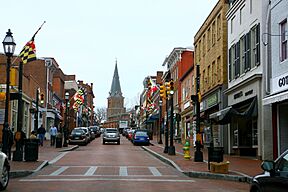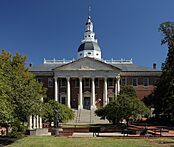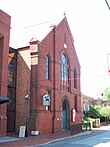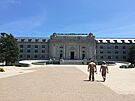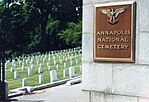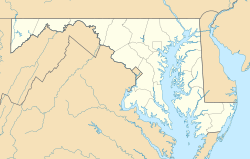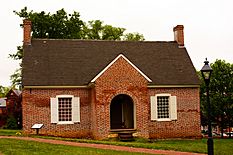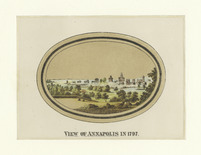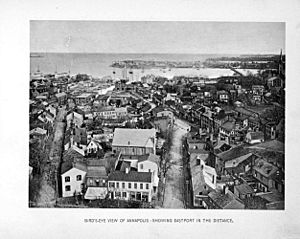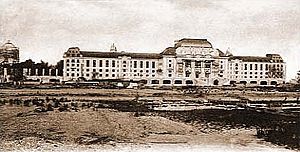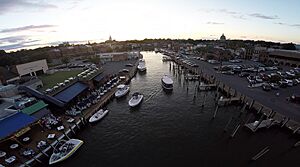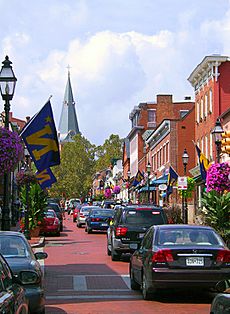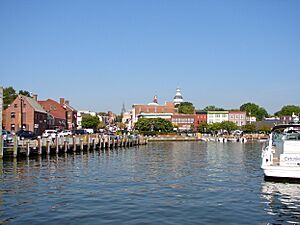Annapolis, Maryland facts for kids
Quick facts for kids
Annapolis
|
|||
|---|---|---|---|
|
Downtown Annapolis
Bancroft Hall
Annapolis National Cemetery
|
|||
|
|||
| Nicknames:
"America's Sailing Capital", "Sailing Capital of the World", "Naptown", "Crabtown on the Bay"
|
|||
| Motto(s):
"Vixi Liber Et Moriar"
("I have lived, and I shall die, free") |
|||
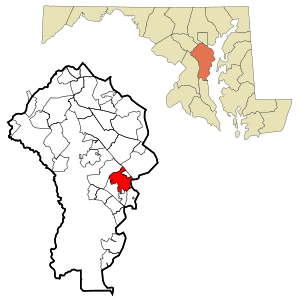
Location within Anne Arundel County
|
|||
| Country | United States | ||
| State | Maryland | ||
| County | Anne Arundel | ||
| Founded | 1649 | ||
| Incorporated | 1708 | ||
| Named for | Princess Anne of Denmark & Norway (later Anne, Queen of Great Britain) | ||
| Government | |||
| • Type | Mayor–council | ||
| • Body | Annapolis City Council | ||
| Area | |||
| • Total | 8.11 sq mi (21.01 km2) | ||
| • Land | 7.21 sq mi (18.66 km2) | ||
| • Water | 0.91 sq mi (2.34 km2) | ||
| Elevation | 43 ft (13 m) | ||
| Population
(2020)
|
|||
| • Total | 40,812 | ||
| • Density | 5,663.61/sq mi (2,186.66/km2) | ||
| Demonym(s) | Annapolitan | ||
| Time zone | UTC−5 (EST) | ||
| • Summer (DST) | UTC−4 (EDT) | ||
| ZIP Codes |
21401-21405, 21409, 21411-21412
|
||
| Area codes | 410, 443, and 667 | ||
| FIPS code | 24-01600 | ||
| GNIS feature ID | 595031 | ||
| Website | www.annapolis.gov | ||
Annapolis (![]() i/əˈnæpəlɪs/ Ə-nap-ƏL-iss) is the capital city of the state of Maryland. It is also the main city of Anne Arundel County. Annapolis is located on the Chesapeake Bay where the Severn River flows into it. It's about 25 miles (40 km) south of Baltimore and 30 miles (50 km) east of Washington, D.C.. In 2020, about 40,812 people lived there.
i/əˈnæpəlɪs/ Ə-nap-ƏL-iss) is the capital city of the state of Maryland. It is also the main city of Anne Arundel County. Annapolis is located on the Chesapeake Bay where the Severn River flows into it. It's about 25 miles (40 km) south of Baltimore and 30 miles (50 km) east of Washington, D.C.. In 2020, about 40,812 people lived there.
Annapolis was once the temporary capital of the United States from 1783 to 1784. During this time, George Washington famously resigned as the leader of the Continental Army in the Maryland State House. A month later, the Treaty of Paris was signed here, officially ending the American Revolutionary War. This treaty made the United States an independent country.
The city also hosted the Annapolis Convention in 1786. This meeting led to the important Constitutional Convention in Philadelphia, where the U.S. Constitution was created.
Today, Annapolis is home to St. John's College, which started in 1696. The United States Naval Academy, a famous military school, was founded nearby in 1845.
Contents
History of Annapolis
Early Settlement and Growth (1649–1808)
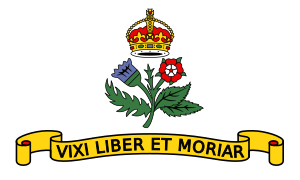
The first settlement in this area was called "Providence." It was founded in 1649 by a group of settlers from Virginia. They later moved to a better spot on the southern shore of the Severn River. This new settlement was first known as "Town at Proctor's," then "Town at the Severn," and by 1694, it was called "Anne Arundel's Towne." This name honored Lady Anne Arundell, the wife of the second Lord Baltimore.
In 1694, the capital of the Maryland colony was moved to Anne Arundel's Towne. The town was then renamed "Annapolis" after Princess Anne of Denmark and Norway, who later became Queen Anne of Great Britain. Annapolis officially became a city in 1708.
In the 1700s, Annapolis grew quickly. It became an important center for trade and government. The Maryland Gazette, a weekly newspaper, started here in 1745. However, after 1780, Baltimore became a bigger port because it had a deeper harbor. This caused Annapolis's trade to slow down. The city then focused more on water-related jobs like boatbuilding. Today, many recreational boats fill the harbor, replacing the old seafood industry.
Dr. Alexander Hamilton (1712–1756), a doctor and writer from Scotland, lived and worked in Annapolis. His travel diary, Gentleman's Progress, gives a great look at life in colonial America.
Annapolis served as the temporary capital of the United States from November 1783 to August 1784. It was here that George Washington resigned his role as commander of the Continental Army in December 1783. Also, the Treaty of Paris, which ended the American Revolutionary War, was approved here in January 1784.
In 1786, a meeting called the "Annapolis Convention" took place. Delegates from five states met to discuss trade. They decided to call for another, larger meeting in Philadelphia the next year. This led to the creation of the Constitution of the United States.
Civil War Era (1849 – late 1800s)
During the American Civil War, the students of the United States Naval Academy moved their base from Annapolis to Rhode Island in 1861. They returned in 1865.
From 1861 to 1865, Annapolis was home to "Camp Parole." This camp held soldiers who had been captured and then released. Over 20,000 soldiers stayed there at one point. The area just west of the city is still called Parole today. Soldiers who died at the camp were buried in the Annapolis National Cemetery.
Modern Times
In 1900, Annapolis had a population of 8,585 people. During World War II, shipyards in Annapolis built military boats. Later, during the Korean and Vietnam wars, they built more ships like minesweepers.
In 1984, the Navy Marine Corps Memorial Stadium in Annapolis hosted soccer games for the 1984 Summer Olympics.
In September 2003, Hurricane Isabel caused the biggest storm surge in Annapolis's history, flooding much of downtown. The city also experiences "sunny day" flooding during high tides, which is becoming more common due to sea level rise. This flooding can cause problems for local businesses.
From 2007 to 2008, Annapolis celebrated its 300th anniversary of becoming a city.
In 2018, a tragic shooting occurred at the Capital Gazette newspaper, where five journalists were killed. In 2021, an EF-2 tornado hit the western part of the city, causing significant damage.
2007 Annapolis Conference
In November 2007, Annapolis hosted an important Middle East peace meeting. Leaders like Israeli Prime Minister Ehud Olmert and Palestinian President Mahmoud Abbas attended the conference at the United States Naval Academy.
Historic Places to Visit
The State House
The Maryland State House is the oldest state capitol building in the United States that is still used by lawmakers. Construction began in 1772. It has the largest wooden dome in the country built without nails. This building was the home of the U.S. government from 1783 to 1784. It was here that the Treaty of Paris was approved, making Annapolis the first peacetime capital of the U.S.
The United States Naval Academy was founded in 1845. It is built on land that was once Fort Severn. Students at the Naval Academy study for four years and then serve in the Marine Corps or Navy for five years. About 4,500 students, called Midshipmen, attend the academy.
St. John's College
St. John's College is a private college that opened in 1789. It took over from King William's School, which started in 1696. The main building, McDowell Hall, was originally planned to be the governor's home.
Geography and Climate
Annapolis is about 25 miles (40 km) south of Baltimore and 30 miles (48 km) east of Washington, D.C.. It is the closest state capital to the national capital.
The city is mostly flat, with its highest point only about 50 feet (15 m) above sea level. Annapolis has a humid subtropical climate. This means it has hot, humid summers and cool winters. Being close to the Chesapeake Bay helps keep temperatures more mild than places further inland.
| Climate data for ANNAPOLIS NAF, MD (1991-2020 normals) | |||||||||||||
|---|---|---|---|---|---|---|---|---|---|---|---|---|---|
| Month | Jan | Feb | Mar | Apr | May | Jun | Jul | Aug | Sep | Oct | Nov | Dec | Year |
| Record high °F (°C) | 77 (25) |
83 (28) |
92 (33) |
95 (35) |
98 (37) |
103 (39) |
105 (41) |
106 (41) |
99 (37) |
94 (34) |
85 (29) |
78 (26) |
106 (41) |
| Mean daily maximum °F (°C) | 43.1 (6.2) |
45.2 (7.3) |
53.1 (11.7) |
63.7 (17.6) |
73.0 (22.8) |
81.5 (27.5) |
86.0 (30.0) |
83.7 (28.7) |
77.4 (25.2) |
67.1 (19.5) |
56.2 (13.4) |
47.2 (8.4) |
64.8 (18.2) |
| Daily mean °F (°C) | 36.5 (2.5) |
38.4 (3.6) |
45.7 (7.6) |
55.4 (13.0) |
65.1 (18.4) |
74.6 (23.7) |
79.0 (26.1) |
77.1 (25.1) |
71.1 (21.7) |
59.7 (15.4) |
49.3 (9.6) |
40.6 (4.8) |
57.7 (14.3) |
| Mean daily minimum °F (°C) | 29.8 (−1.2) |
31.5 (−0.3) |
38.3 (3.5) |
47.2 (8.4) |
57.3 (14.1) |
67.7 (19.8) |
71.9 (22.2) |
70.5 (21.4) |
64.8 (18.2) |
52.2 (11.2) |
42.3 (5.7) |
34.1 (1.2) |
50.7 (10.4) |
| Record low °F (°C) | −8 (−22) |
−6 (−21) |
10 (−12) |
13 (−11) |
32 (0) |
35 (2) |
50 (10) |
46 (8) |
37 (3) |
26 (−3) |
13 (−11) |
−1 (−18) |
−8 (−22) |
| Average precipitation inches (mm) | 2.84 (72) |
2.38 (60) |
3.80 (97) |
3.38 (86) |
3.15 (80) |
4.04 (103) |
4.94 (125) |
4.27 (108) |
5.14 (131) |
4.04 (103) |
3.03 (77) |
2.98 (76) |
43.99 (1,117) |
| Average precipitation days (≥ 0.01 in) | 9.0 | 9.0 | 11.0 | 11.0 | 12.0 | 11.0 | 12.0 | 11.0 | 10.0 | 9.0 | 8.0 | 10.0 | 116.0 |
| Source: NOAA | |||||||||||||
| Climate data for Annapolis | |||||||||||||
|---|---|---|---|---|---|---|---|---|---|---|---|---|---|
| Month | Jan | Feb | Mar | Apr | May | Jun | Jul | Aug | Sep | Oct | Nov | Dec | Year |
| Average sea temperature °F (°C) | 46.7 (8.2) |
45.1 (7.3) |
46.0 (7.8) |
51.5 (10.8) |
57.4 (14.1) |
69.1 (20.6) |
76.1 (24.5) |
77.8 (25.4) |
73.9 (23.3) |
66.7 (19.3) |
57.9 (14.4) |
51.7 (10.9) |
60.0 (15.6) |
| Mean daily daylight hours | 9.8 | 10.8 | 12.0 | 13.3 | 14.3 | 14.9 | 14.6 | 13.6 | 12.4 | 11.2 | 10.1 | 9.5 | 12.2 |
| Source: Weather Atlas | |||||||||||||
Tidal Flooding in Annapolis
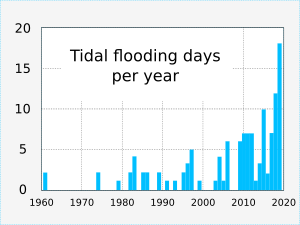
Annapolis experiences "high-tide flooding," also known as "sunny day flooding." This happens when high tides cause flooding even without a storm. This type of flooding is increasing due to sea level rise from climate change. For example, from May 2019 to April 2020, Annapolis had 18 days of this flooding. This is much more than the average of 2 days per year from 1995-2005. This flooding can cause businesses to lose money.
Neighborhoods and Nearby Areas
- Admiral Heights
- Arnold
- Arundel on the Bay
- Cape St. Claire
- Church Circle and St. Anne's Church
- Crofton
- Crownsville
- Eastport
- Edgewater
- Highland Beach
- Gambrills
- Hillsmere Shores
- Londontowne
- Main Street, City Dock and City Markethouse
- Millersville
- Naval Academy
- Odenton
- Parole - This area was once a Civil War prisoner-of-war camp.
- Riva
- St. Margaret's
- State Circle and Maryland Avenue - Home to the State House and other government buildings.
- West Annapolis
- West Street / Arts District
Population and People
| Historical population | |||
|---|---|---|---|
| Census | Pop. | %± | |
| 1820 | 2,260 | — | |
| 1830 | 2,623 | 16.1% | |
| 1840 | 2,792 | 6.4% | |
| 1850 | 3,011 | 7.8% | |
| 1860 | 4,529 | 50.4% | |
| 1870 | 5,744 | 26.8% | |
| 1880 | 6,642 | 15.6% | |
| 1890 | 7,604 | 14.5% | |
| 1900 | 7,657 | 0.7% | |
| 1910 | 8,262 | 7.9% | |
| 1920 | 8,518 | 3.1% | |
| 1930 | 9,803 | 15.1% | |
| 1940 | 9,542 | −2.7% | |
| 1950 | 10,047 | 5.3% | |
| 1960 | 23,385 | 132.8% | |
| 1970 | 30,095 | 28.7% | |
| 1980 | 31,740 | 5.5% | |
| 1990 | 33,187 | 4.6% | |
| 2000 | 35,838 | 8.0% | |
| 2010 | 38,394 | 7.1% | |
| 2020 | 40,812 | 6.3% | |
| U.S. Decennial Census | |||
Population in 2020
In 2020, Annapolis had 40,812 people.
- About 49.4% were White (not Hispanic).
- About 21.7% were African American.
- About 2.5% were Asian.
- About 22.9% were Hispanic or Latino (of any race).
Economy and Jobs
Annapolis has many different types of jobs. Here are some of the top employers in the city, not including state and local government jobs:
| # | Employer | Employees |
|---|---|---|
| 1 | United States Naval Academy | 2,500 |
| 2 | ARC of the Central Chesapeake Region | 502 |
| 3 | Annapolis Marriott Waterfront Hotel | 215 |
| 4 | St. John's College | 204 |
| 5 | Comtech Telecommunications Corp. | 200 |
| 6 | Federal Catering | 180 |
| 7 | Buddy's Crabs & Ribs, Inc. | 167 |
| 8 | Loews Annapolis Hotel | 166 |
| 9 | Severn Bancorp Inc. | 163 |
| 10 | Rams Head Tavern, Inc. | 140 |
Arts and Culture
Theater in Annapolis
Annapolis has a lively theater scene with several places to see shows.
- Colonial Players: This group puts on about six shows each year in their 180-seat theater. Their musical version of A Christmas Carol has been a holiday tradition since 1981. Colonial Players started in 1949.
- Annapolis Summer Garden Theatre: In warmer months, this theater presents three shows on its outdoor stage near the City Dock. They have been offering "theatre under the stars" since 1966.
- Naval Academy Masqueraders: This is a theater group at the United States Naval Academy. They perform one main show in the fall and student-directed plays in the spring. It's the oldest extracurricular activity at the Naval Academy, started in 1847.
- King William Players: Students at St. John's College have their own theater group. They perform twice each semester, and admission is usually free.
Museums and Historic Sites
- Banneker-Douglass Museum: Located in the historic Mount Moriah Church, this museum tells the story of African Americans in Maryland. It opened in 1984 and offers educational programs and exhibits. Admission is free.
- U.S. Naval Academy Museum: Found in Preble Hall, this museum was started in 1845. It has a large collection of prints showing European and American naval history. It also has one of the world's best collections of ship models.
- Hammond-Harwood House: This historic house was built in 1774. It is a great example of an 18th-century mansion. Today, it is a museum with old furniture and paintings.
- Annapolis City Dock: This area is at the end of Main Street. It's a narrow waterway that leads into the city. The dock is now mostly used by recreational boats. The area is part of the Colonial Annapolis National Historic Landmark District.
- Kunta Kinte-Alex Haley Memorial: This memorial is in a park at the City Dock. It honors the arrival of Kunta Kinte, an African ancestor of author Alex Haley, whose story is told in the book Roots: The Saga of an American Family. The memorial has sculptures of Alex Haley reading to children.
- Paca House and Garden: This property includes an 18th-century mansion built by William Paca, who signed the Declaration of Independence. It also has a beautiful garden that has been restored to how it looked in colonial times.
- Thurgood Marshall Monument: North of the State House, there is a monument to Thurgood Marshall. He was the first Black justice on the US Supreme Court and a civil rights lawyer from Maryland.
- World War II Memorial: This memorial was built in 1998 to honor the 275,000 Maryland citizens who served in World War II. It has 48 granite columns, representing the 48 states at the time, surrounding an area with the names of 6,454 men who died in the war.
Sports
- Chesapeake Bayhawks: This professional lacrosse team moved to Annapolis in 2010. They play at the Navy–Marine Corps Memorial Stadium. In 2013, they won the league championship, the Steinfeld Cup, for the fifth time.
- Annapolis Blues FC: This is a men's amateur soccer team that also plays at Navy–Marine Corps Memorial Stadium.
Parks and Recreation
Annapolis has over 200 acres (81 ha) of parkland. The largest is Truxtun Heights Park, which is 70 acres. Quiet Waters Park is a large regional park with water access, a playground, over six miles of paved trails, an ice skating rink, and a dog beach.
Some community parks include:
- Bayhead Park
- Bestgate Park
- Broad Creek Park
- Broadneck Park
- Browns Wood Park
- Generals Highway Corridor Park
- Jones and Anne Catharine Park
- Peninsula Park
- Truxton Park
- Whitmore Park
- Wiley H. Bates Heritage Park
Events and Festivals
Annapolis hosts many fun events and festivals throughout the year. These include the annual St. Patrick's Day Parade, May Day, and the United States Naval Academy Commissioning Week.
Education
Annapolis is part of the Anne Arundel County Public Schools system. Annapolis High School, founded in 1896, has a special IB International Program.
Public schools in the Annapolis area:
- Annapolis High
- Annapolis Middle
- Bates Middle
- Annapolis Elementary
- Eastport Elementary
- Georgetown East Elementary
- Germantown Elementary
- Hillsmere Elementary
- Mills-Parole Elementary
- Rolling Knolls Elementary
- Tyler Heights Elementary
- West Annapolis Elementary
There are also several private schools in the area, such as St. Anne's School of Annapolis, Aleph Bet Jewish Day School, Annapolis Area Christian School, St. Martins Lutheran School, Severn School, St. Mary's High School (Annapolis, Maryland), and Indian Creek School. The Key School has been serving Annapolis for over 50 years.
Media
The Capital is a newspaper that covers news in Annapolis and Anne Arundel County. Annapolis also has its own radio station, WNAV.
Chesapeake Inspired is an online magazine that shares stories about people, places, and food in Annapolis and the Chesapeake Bay area.
Transportation
Roads and Highways
No major highways go directly into Annapolis. However, Interstate 595/U.S. Route 50/U.S. Route 301 runs just outside the city. This road connects Annapolis to Washington, D.C. and the Eastern Shore of Maryland. Interstate 97 connects to this highway and provides a direct route to Baltimore.
Important roads that lead into Annapolis include Maryland Route 70 and Maryland Route 665. Other state highways serving the city are Maryland Route 181, Maryland Route 387, Maryland Route 393, Maryland Route 435, Maryland Route 436, Maryland Route 450, Maryland Route 788 and Maryland Route 797.
Bus Service
The Annapolis Department of Transportation (ADOT) offers bus service with eight routes, called Annapolis Transit. These buses connect different parts of the city, including parks, shopping centers, schools, and hospitals. ADOT also provides transportation for elderly people and those with disabilities. You can also take Maryland Transit Administration commuter buses to Baltimore or Washington, D.C.
Old Railway Lines
From 1840 to 1968, trains connected Annapolis to other cities. The Washington, Baltimore and Annapolis Electric Railway (WB&A) had two electric train lines. One went down King George Street and Main Street to the State House. The other came from Glen Burnie. Train service eventually stopped in 1950, and the tracks were removed in 1976.
Famous People from Annapolis
Athletes
- Devin Barclay (1983–), soccer and football player
- Bill Belichick (1952–), football coach, lived in Annapolis
- Donald Brown (1963–), pro football player
- Debbie Meyer (1952–), Olympic swimming gold medalist, born in Annapolis
- Travis Pastrana, X Games athlete and founder of Nitro Circus
- Mark Teixeira (1980–), retired professional baseball player, born in Annapolis
Artists and Writers
- James M. Cain (1892–1977), author of famous novels like Double Indemnity
- Michele Carey (1942–2018), actress
- Robert Duvall, actor, lived in Annapolis
- Barbara Kingsolver (1955–), novelist and poet, born in Annapolis
- Christian Siriano, fashion designer and winner of Project Runway
- Thorne Smith (1892–1934), author of Topper
- Stan Stearns (1935−2012), photographer known for a famous image of John F. Kennedy Jr.
Images for kids
See also
 In Spanish: Annapolis para niños
In Spanish: Annapolis para niños


